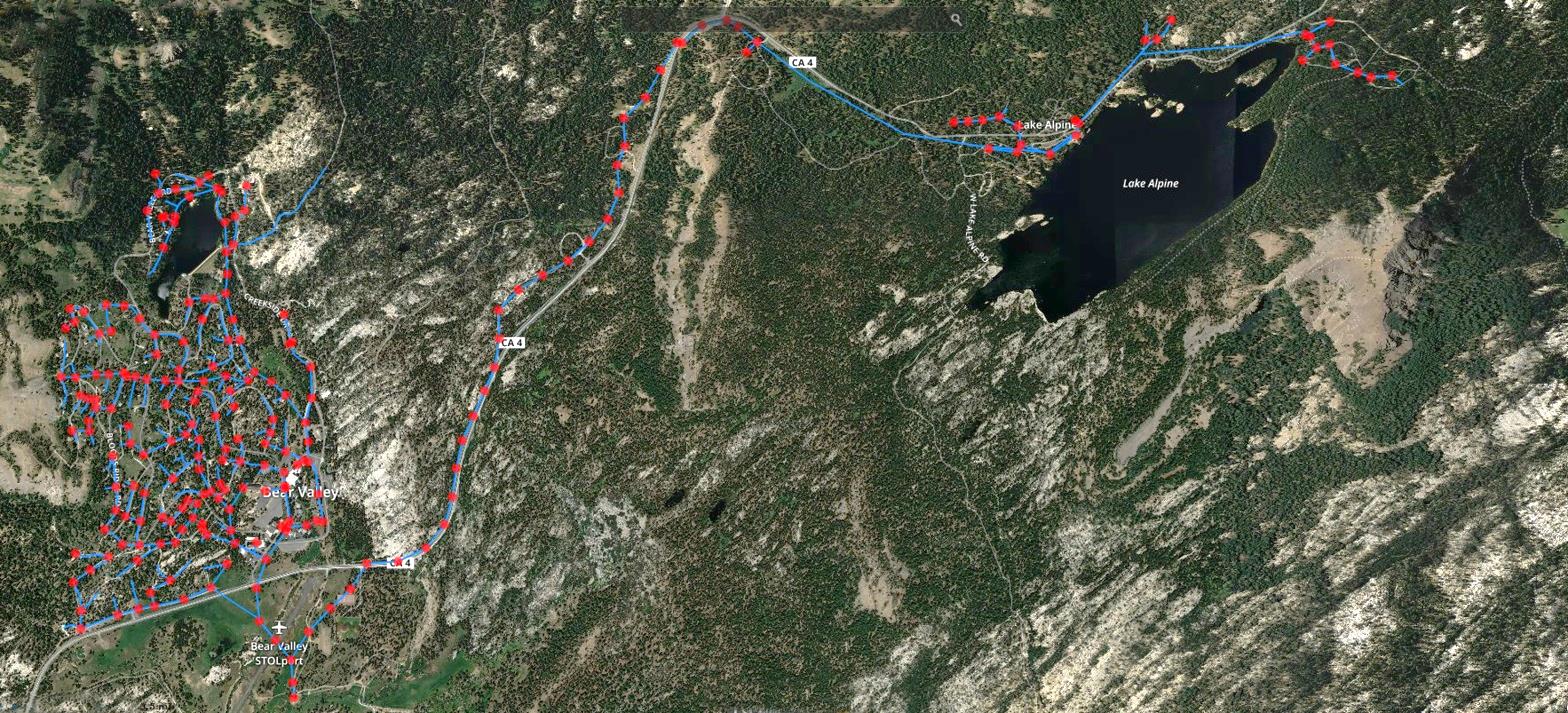Wastewater System: Collection, Treatment & Disposal

The Bear Valley Water District (District) provides sanitary sewer collection, treatment and disposal for approximately 650 residential and commercial Equivalent Dwelling Units (EDUs) in the Alpine County community of Bear Valley. The District’s service area is comprised of approximately 3000 acres located primarily north of California State Highway 4. The District serves the developed private, residential and commercial areas of the Bear Valley village as well as the developed adjoining federal recreational lands including the United States Forest Service’s (USFS) Lake Alpine Resort and campgrounds, special use permit (SUP) residential cabins and the Bear Valley Mountain downhill ski resort. The District’s wastewater treatment and disposal facility (WWTF) is regulated by the Central Valley Regional Water Quality Control Board (Regional Board) under Waste Discharge Requirements (WDRs) Order No. 5-01-208 and Order No. R5-2022-0037.
Wastewater Collection
The District’s collection system includes approximately 83,000 linear feet or nearly 16 miles of gravity sewer collection pipeline and 8,560 linear feet or about 1.5 miles of force main pressured lines as well as 160 manholes and 3 pump stations. The pipeline ranges in size from 4 inches to 12 inches in diameter. The 3 pump stations lift wastewater throughout the collection system as it travels to the wastewater treatment facility.
Wastewater Treatment
Wastewater from the colletion system flows to the District's wastewater treatment plant located in the meadow on the south side of Highway 4. The District provides secondary treatment with a facility design flow of 0.5 million gallons per day (MGD) (500,000 gallons per day) while the system has safely received over 1.5 MGD during significant hydraulic events. The goal of the treatment process is to remove as many pollutants in the wastewater as possible to minimize the risks to public health and impact on the environment and return the treated wastewater safely back to the environment.
Preliminary treatment at the District’s main pump station (headworks) consists of shredding (comminutor) and grit removal before the influent reaches the primary sedimentation tank where the settable solids are allowed to fall to the bottom of the tank. Effluent flow is then measured during transfer via three, 10 horse power (HP) Paco pumps to a 14.18 MG, two cell, aerated treatment lagoon for secondary biological nutrient removal.
While in the two cell lagoon system, air is delivered via one 40 HP, variable frequency drive (VFD) Gardner Denver positive displacement blower to twelve (12) Triplepoint Mars T-Series Double Bubble fine and coarse bubble diffusers. Through this biological treatment method, the constituents are largely consumed and/or sequestered. Inline YSI sensors communicate with the VFD blower by way of the SCADA system to keep dissolved oxygen and suspended solids at optimum levels. Treated effluent from the aerated lagoon is then disinfected during transfer via (2) - 375 gallon per minute (GPM) Paco pumps through a 12,000 gallon chlorine contact tank. The disinfected effluent is then placed into storage and receives further treatment in a 76.4 MG effluent polishing reservoir.
Wastewater Disposal
During the irrigation season, typically late spring through early autumn, the polished effluent is disposed of through spray irrigation on up to approximately 80 acres of sprayfields: 40 acres of land which is authorized by Special Use Permit (SUP) from the USFS and 40 acres under private lease through 2048. Both the leased disposal area and the permitted land have been in service since before the installation of the groundwater monitoring wells (approximately 40 years for the leased land) at the site.
Effluent disposal via spray irrigation involves the disbursement of the effluent through low impact, high uniformity, Nelson sprinkler heads upon soils and vegetation within the disposal area. The average monthly application rates during the peak disposal months range from approximately 1.3 MG - 12.333 MG per month (0.060 MG – 0.562 MG per acre per month). The water is allowed to percolate into the soil and evapotranspirate into the atmosphere. WDRs Order No. 5-01-208 limit application of wastewater to reasonable rates considering soil, climate, and irrigation management system.
Polished effluent may also be discharged to surface waters as a means of effluent disposal. To protect surface waters, sodium bisulfite is used to remove the chlorine residual. The dechlorinated water is then discharged to Bloods Creek. The discharge is strictly monitored by plant personnel to ensure a quality effluent that complies with state-regulated limits to meet permit compliance under Order No. R5-2022-0037.